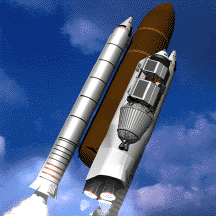Shuttle C - Heavy Lift Vehicle (HLV)
This page is devoted to popularizing a concept of a heavy lift vehicle
derived from the current Space Shuttle configuration. As I find out more
about it, I will post the info here.
It is my contention that in order to have a serious manned return to the Moon, or a manned trip to Mars, the nation needs a viable heavy lift vehicle. One could also say that heavy lift is the most practical way in which to launch a space station into orbit. We once had a heavy lift vehicle called the Saturn-V. It was the vehicle which got us to the Moon. At that time, the Russians were unable to make their heavy lift rocket, the N-1, work successfully and thus did not make a credible launch attempt at landing a man on the Moon. More recently the Russians developed the Energia rocket, which would have been the booster for their shuttle, except for the fact that their economy and then their space program ran out of steam. Reflecting on this situation, we realize that we may also have a potential heavy lift booster in our Shuttle configuration - except that our own space program may well be running out of steam. In recent congressional hearings, several former astronauts lamented the current situation concerning America's exploration of space - or rather, lack thereof. Realizing that many things which may be technically feasible become possible only if there is the will to accomplish them, we as a nation need to reawaken the pioneer spirit which brought us to this great continent several hundred years ago. The Moon and Mars, as well as the wealth of the entire solar system, beckon us to reach out from our comfortable nest of Mother Earth. To reach the new lands requires a certain amount of commitment, as well as a great deal of cleverness and talent. In the 1960's we accomplished this with a vast national project called Apollo. The taste of that victory has become sour with age, as the quest was all but abandoned over the last 25 years. We lost our taste for manned exploration, and with it our heavy lift capability. But we did build Shuttle, a semi-reusable multi-purpose manned vehicle for reaching Low-Earth Orbit (LEO). And despite the fact that it did not substantially reduce the cost of getting into Space, we still have a unique capacity to send, on a nearly monthly basis, a half-dozen or so highly-trained group of astronauts into space on something ressembling a small space station for a couple of weeks. It is an odd craft, so much larger than the tiny capsules of the 1960's, yet confined to LEO. It is not the latest and greatest technology, but it is an operational vehicle which has logged many flight hours. And the mass of the craft which is placed into orbit is several tens of tons. This then is the basis for Shuttle-C - given the will of a pioneering people to venture to new worlds, the need for a heavy lift vehicle to get us there, and the existence of an existing operational vehicle with many of the characteristics desired. At its core, a cargo version of the Space Shuttle would still have a large External Tank and solid rockets strapped to its sides. It would still be propelled by the same main engines burning the same mixture of oxygen and hydrogen. Only the orbiter would be different. It would be a cargo pod instead, designed to deliver as much mass as possible into orbit, without astronauts or re-entry capability. It is one of the simplest possible Shuttle derivatives. Shuttle-C has been proposed, studied, redesigned, shelved, and nearly forgotten. Yet it is still the most practical method for realizing our goals of manned planetary exploration, at least in the near-term. The estimated cost is about $2 billion, the cost of another Shuttle. Or the yearly expenditure on Space Station, which like the current Mir station of the Russians, will sit in LEO, still orbiting the Earth. Want to go to the Moon or Mars? Then build Shuttle-C.
From http://calvin.ksc.nasa.gov:1080/nexgen/rlvhq10.htm Shuttle-C was envisioned to fill the gap between shuttle and ALS5. Using an unmanned cargo carrier in place of the orbiter, Shuttle-C was compatible with existing shuttle infrastructure and offered a heavy-lift capability (up to 150K lbs. to low earth orbit) within a four year window. In the spring of 1989 a Shuttle-C Users Conference was sponsored at Huntsville, Alabama to enlighten the user community of system capabilities and determine a preliminary mission model. The then Space Station Freedom was targeted at that time as a potential user in the space station assembly sequence and the logistics resupply missions. Due to sharing the development costs, the space station community was not ready to commit to using the Shuttle-C. The message from other potential users was "build it and we will come"; however, no one was willing to step up and commit to Shuttle-C. With no clear definition of annual utilization the program was ultimately terminated. References:Cris A Fitch fitch@isat.com |